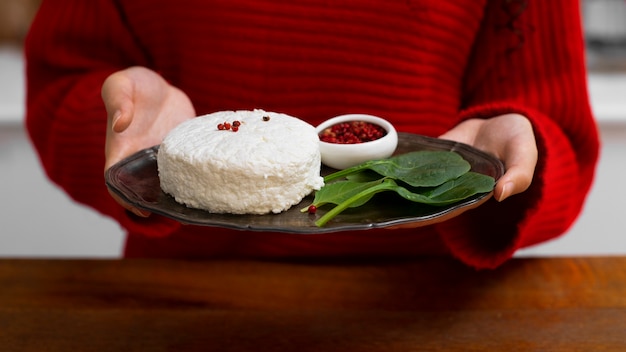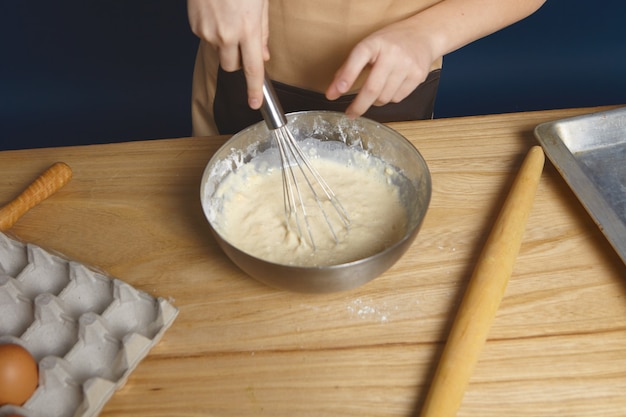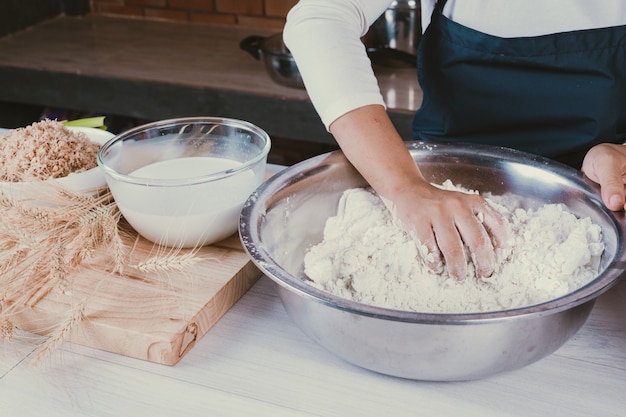There's a certain magic to a bowl of perfectly cooked rice. Whether it's the fluffy, light texture of long grain rice, the fragrant aroma of jasmine rice, or the sticky, deliciousness of short grain rice, a good bowl of rice can elevate any meal. But achieving that "just right" consistency can feel like a culinary puzzle. For years, I wrestled with inconsistent results, burnt pots, and a whole lot of frustration trying to master rice cooking. But then, I discovered the world of rice steamers, and my rice-making journey changed forever.
(Part 1) The Rice Steamer: Your Kitchen's Secret Weapon

Before we dive into the science of timing, let's talk about the unsung hero: the rice steamer. It's not just a fancy kitchen gadget; it's a game changer. Think of it as having a dedicated mini-chef in your kitchen, tirelessly working to deliver perfect results. And it's not limited to just rice, it's a versatile tool for cooking a range of dishes.
The Rice Steamer's Magic
The key to a rice steamer's success lies in its self-contained system. The rice cooks in a separate container, surrounded by a gentle blanket of steam. This eliminates the risk of sticking or burning, ensuring a perfectly even cook every time. You can set it and forget it, freeing you to focus on other tasks without worrying about your rice getting overcooked or burnt.
Choosing the Right Steamer
There's a rice steamer for every kitchen and every need. Basic models consist of a single level with a rice bowl and a water basin beneath. They are perfect for smaller batches. For larger families or those who love to experiment, multi-level steamers are a fantastic choice. They allow you to cook other dishes alongside your rice, like fish, vegetables, or even dumplings. This multitasking ability makes them incredibly convenient and efficient.
(Part 2) Getting to Know Your Rice

Now that you have the perfect tool, it's time to get acquainted with the star of the show: the rice itself. Understanding the nuances of different rice types is crucial for achieving consistently delicious results.
Exploring the World of rice varieties
Let's break down some of the most common rice types you'll find at your local supermarket:
- Long Grain Rice: This classic rice is known for its fluffy, separate grains. It’s perfect for pilafs, side dishes, and even rice salads where a light texture is desired.
- medium grain rice: This versatile rice strikes a balance between fluffiness and stickiness. It's great for a variety of dishes, from savory fried rice and stir-fries to sweet desserts.
- Short Grain Rice: This is the champion of stickiness. Its unique texture makes it ideal for sushi, rice balls, and even mochi.
- brown rice: A whole grain powerhouse, brown rice boasts a nutty flavor and a chewier texture than its white counterpart. It takes a bit longer to cook due to its intact bran and germ but provides a hearty and nutritious meal.
- wild rice: Technically, wild rice is not a true rice but the seed of an aquatic grass. It has a distinct nutty flavor and a chewy texture, often used as a side dish or mixed with other grains.
The Ratio Game: Water and Rice
The secret to perfect rice isn't just about the cooking time, it's also about the precise ratio of rice to water. The general rule for most rice types is a 1:1 ratio – one cup of rice to one cup of water. However, this can vary slightly depending on the type of rice. Always check the package instructions for specific recommendations.
(Part 3) The Rice Steamer Cooking Time Guide

Now that you understand the fundamentals, let's get to the heart of the matter – the actual cooking times.
A General Guide to Steaming Time
For most white rice varieties (long grain and medium grain), the typical steaming time in a rice steamer is 20-25 minutes. However, factors such as the specific rice variety, the quantity being cooked, and even the power of your steamer can influence the cooking time.
A Handy Chart for Your Rice Steaming Journey
Here’s a handy chart to serve as your guide, but remember, always check the package instructions for your specific rice:
| Type of Rice | Cooking Time (Minutes) |
|---|---|
| Long Grain White Rice | 20-25 |
| Medium Grain White Rice | 22-27 |
| Short Grain White Rice | 25-30 |
| Brown Rice | 45-60 |
| Wild Rice | 40-45 |
Factors Influencing Cooking Time
Here are some key factors that can impact your rice steaming time:
- Quantity of Rice: As you increase the amount of rice, it naturally takes longer for the steam to penetrate and cook the entire batch. Think of it as a bigger batch needing a bit more time to reach perfection.
- Steamer Power: Different rice steamers have different wattages, affecting their heating efficiency. A steamer with higher wattage might cook faster than a lower wattage model.
- Altitude: If you live at a higher altitude, the boiling point of water is lower, meaning your rice might require a slightly longer steaming time to reach the desired texture.
(Part 4) Mastering the Art of Checking for Doneness
Your rice is steaming away in the appliance, and the timer is ticking down. But how do you know when it's reached peak perfection?
The Fork Test: A Classic Approach
This tried-and-true method is a favourite among rice enthusiasts. After the minimum steaming time has elapsed, carefully insert a fork into the centre of the rice. If it comes out clean, with no wet rice clinging to it, your rice is cooked through.
The Look Test: Relying on Your Eyes
Experienced cooks often rely on their keen observation. The rice should be fluffy and opaque, with no visible water remaining in the bottom of the steamer.
The Touch Test: A Gentle Poke
This requires a bit of finesse, but a gentle poke on the rice can reveal a lot about its texture. It should feel soft and slightly springy, not hard or wet.
(Part 5) Tips for the Perfect Bowl of Rice
Now that you have the timing down, let's add a few extra tips to elevate your rice game from good to exceptional.
Rinsing the Rice: Removing Excess Starch
This crucial step ensures a lighter, fluffier texture. Rinsing your rice before steaming removes excess starch, preventing it from becoming sticky and clumpy. Simply place the rice in a fine-mesh sieve and rinse under cold water until the water runs clear.
Soaking the Rice: Enhancing Texture
While not always necessary, soaking your rice for 30 minutes before steaming can improve texture and even slightly reduce cooking time. This is particularly beneficial for brown rice, as it can help make it more tender.
Adding Seasonings: Flavor Boosters
Don't be afraid to experiment! Adding a pinch of salt, a splash of olive oil, or a sprinkle of herbs or spices while the rice is steaming can enhance the flavor profile.
Letting the Rice Rest: The Final Touch
Once the rice is cooked, resist the urge to dig in immediately. Allow it to rest in the steamer for a few minutes with the lid closed. This allows the rice to absorb the remaining moisture, resulting in a perfectly fluffy, delicious texture.
(Part 6) Rice Steamer Recipes: Beyond the Basics
Let's put your newfound timing skills to work with some delicious rice recipes, perfect for your rice steamer.
1. Classic Steamed Rice: The Foundation
This is the essential starting point, a versatile blank canvas for your favorite toppings.
- 1 cup long grain white rice
- 1 cup water
- Pinch of salt
Rinse the rice thoroughly and place it in the steamer bowl. Add the water and salt. Steam for 20-25 minutes, or until the rice is cooked through.
2. Jasmine Rice with Coconut Milk: A Taste of the Tropics
This fragrant rice infuses your dish with a delicate sweetness. It pairs perfectly with Thai curries or stir-fries.
- 1 cup jasmine rice
- 1 1/2 cups water
- 1/2 cup coconut milk
- Pinch of salt
Rinse the rice and place it in the steamer bowl. In a separate bowl, whisk together the water, coconut milk, and salt. Pour the mixture over the rice. Steam for 20-25 minutes, or until the rice is cooked through.
3. sticky rice for Sushi: The Ultimate Sushi Base
For those sushi cravings, mastering sticky rice is essential. This recipe will help you create the perfect foundation for your sushi rolls.
- 1 cup short grain rice
- 1 1/4 cups water
- 1 tablespoon rice vinegar
- 1 teaspoon sugar
- 1/2 teaspoon salt
Rinse the rice and place it in the steamer bowl. In a separate bowl, whisk together the water, rice vinegar, sugar, and salt. Pour the mixture over the rice. Steam for 25-30 minutes, or until the rice is cooked through. Let the rice cool slightly before using it in your sushi creations.
4. Spiced Brown Rice: A Hearty and Flavorful Side
Brown rice is a nutritional powerhouse, offering fiber and essential nutrients. Enhance its natural flavor with spices for a satisfying and flavorful side dish.
- 1 cup brown rice
- 1 1/4 cups water
- 1/2 teaspoon curry powder
- 1/4 teaspoon ground cumin
- Pinch of salt
Rinse the rice and place it in the steamer bowl. In a separate bowl, whisk together the water, curry powder, cumin, and salt. Pour the mixture over the rice. Steam for 45-60 minutes, or until the rice is cooked through.
(Part 7) Beyond Rice: Expanding Your Steaming Horizons
Your rice steamer is not just for rice! It's a versatile tool for a whole range of culinary creations.
Steaming Vegetables: Nutrient-Rich and Flavorful
Steaming is one of the healthiest ways to cook vegetables, preserving their nutrients and vibrant colors. It's a simple method that allows you to customize cooking times based on the type of vegetable.
- Soft Vegetables: Broccoli, asparagus, green beans, spinach (3-5 minutes)
- Harder Vegetables: Carrots, potatoes, Brussels sprouts (8-10 minutes)
Steaming Fish: Light and Delicious
For a light and flavorful meal, try steaming fish. It's a simple, healthy, and incredibly delicious way to prepare seafood.
- Fish fillets: Salmon, cod, tilapia (10-15 minutes)
- Whole fish: Sea bass, trout (15-20 minutes)
Steaming Dumplings: A Delectable Treat
Whether homemade or store-bought, dumplings are a perfect steamed treat. Your rice steamer is the ideal tool for achieving perfectly cooked and flavorful dumplings.
(Part 8) FAQs
I've been there, asking all the questions about rice and rice steaming. Here are some answers to your most frequently asked questions.
1. Can I use a rice cooker for steaming?
While rice cookers do have a steaming function, they are not as efficient as dedicated rice steamers. Rice steamers are designed specifically for steam, creating a more consistent and even cook.
2. What if my rice isn't perfectly cooked?
Don't fret, it happens to the best of us. If your rice is too wet, you can try steaming it for a few more minutes, or spread it out on a baking sheet to dry it out slightly. If it's too dry, add a little water and steam it again until it reaches the desired texture.
3. Can I add oil to my rice while steaming?
While you can add a small amount of oil for flavor, it's not necessary. The rice should release its natural oils during the steaming process. Adding too much oil can make the rice greasy.
4. How long can I keep cooked rice in the refrigerator?
Cooked rice can be safely stored in the refrigerator for up to 4 days. Reheat it in the microwave or on the stovetop for a quick and easy meal.
5. What are some other things I can steam in my rice steamer?
The possibilities are endless! You can steam chicken breasts, pork chops, tofu, eggs, and even quinoa, couscous, or other grains.
There you have it – your comprehensive guide to mastering rice steamer cooking times and achieving perfect rice every time. Embrace the journey, experiment with different rice types and recipes, and enjoy the delicious results. So get out your steamer, gather your rice, and let's create some culinary magic together!
Everyone is watching

How to Cook Frozen Lobster Tails Perfectly: A Step-by-Step Guide
RecipesLobster. Just the word conjures up images of lavish meals, special occasions, and a taste of luxury. But let's...

Pigs in a Blanket Cooking Time: How Long to Bake for Perfect Results
RecipesAh, pigs in a blanket. Just the name conjures up images of those delightful little parcels of crispy pastry en...

Pork Fillet Cooking Time: How Long to Cook It Perfectly
RecipesPork fillet, or tenderloin as it's sometimes called, is a real favourite in our house. It's so versatile, and...

The Ultimate Guide to Tender, Juicy Pulled Pork
RecipesRight, let's talk pulled pork. It's one of those dishes that just screams "comfort food," doesn't it? I mean...

The Ultimate Guide to Cooking Sweet Potatoes: From Roasting to Mashing
RecipesSweet potatoes. Just the name conjures up images of warm, comforting dishes, bursts of vibrant color, and a to...
